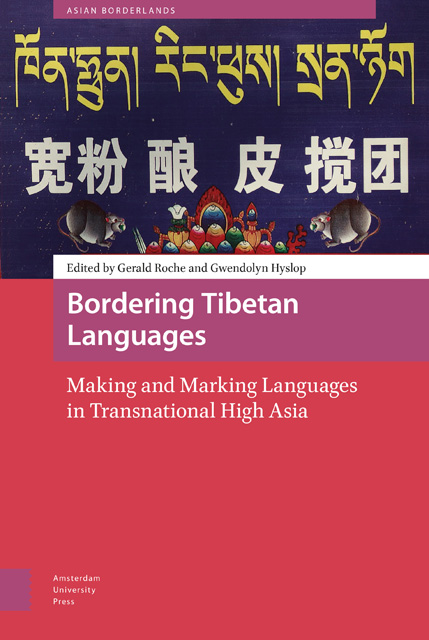Book contents
- Frontmatter
- Table of Contents
- Acknowledgements
- About the Cover Image
- 1 Introduction: Bordering Tibetan Languages: Making and Marking Languages in Transnational High Asia
- 2 Playing with Language Boundaries: Heteroglot Standard Language Ideology and Linguistic Belonging among Amdo Children
- 3 The Role of Classical Tibetan (Chöke) on the Development of Kurtöp, a Language of Bhutan
- 4 Reimagining Rongring without Tibetan Buddhist Influence
- 5 Glottonyms, Identity, and Language Recognition in the Eastern Tibetosphere
- 6 On the Yak Horns of a Dilemma: Diverging Standards in Diaspora Tibetan
- 7 Changing Identity and Linguistic Practices in Nubri: Veiled Language Endangerment in the Nepalese Tibetosphere
- 8 Borderline Dominance: Transnational Tibetan Language Politics in the Himalayas
- 9 Borders: In Conclusion
- Tibetan Language Summaries
- Asian Borderlands
- Index
6 - On the Yak Horns of a Dilemma: Diverging Standards in Diaspora Tibetan
Published online by Cambridge University Press: 24 November 2022
- Frontmatter
- Table of Contents
- Acknowledgements
- About the Cover Image
- 1 Introduction: Bordering Tibetan Languages: Making and Marking Languages in Transnational High Asia
- 2 Playing with Language Boundaries: Heteroglot Standard Language Ideology and Linguistic Belonging among Amdo Children
- 3 The Role of Classical Tibetan (Chöke) on the Development of Kurtöp, a Language of Bhutan
- 4 Reimagining Rongring without Tibetan Buddhist Influence
- 5 Glottonyms, Identity, and Language Recognition in the Eastern Tibetosphere
- 6 On the Yak Horns of a Dilemma: Diverging Standards in Diaspora Tibetan
- 7 Changing Identity and Linguistic Practices in Nubri: Veiled Language Endangerment in the Nepalese Tibetosphere
- 8 Borderline Dominance: Transnational Tibetan Language Politics in the Himalayas
- 9 Borders: In Conclusion
- Tibetan Language Summaries
- Asian Borderlands
- Index
Summary
Abstract
‘Standard Tibetan’ – a state-building project of the Tibetan Empire – dates to the seventh-eleventh centuries CE. This medieval variety of Central Tibetan remains a cultural touchstone today. Its traditional spellings and grammars are still the reference points that define ‘proper’ Tibetan. However, while this standard has been maintained for writing, speech forms have continued to evolve over the last thousand years. In Himalayan settlements especially, movement, migration, and mixture have quickened the pace of language change. The result is diglossia – two horns of a dilemma, between which the borders grow ever taller. This chapter takes a closer look at these borders between traditional ‘Standard Tibetan’ and modern ‘Diaspora Tibetan’, and the dilemmas they create for education and literacy.
Keywords: Diaspora Tibetan, Standard Tibetan, language change, diglossia, education, literacy, language ideology, language insecurity, language anxiety, readability
Introduction
‘Standard Tibetan’ is the result of a state-building project of the Tibetan Empire. Tradition says that the Tibetan Emperor, Srongbtsan sGampo, sent one of his ministers, Tonmi Sambhoṭa, to India in the seventh century CE. It's reported that, when he came back, he created a script for Tibetan, and wrote several grammars (Tournadre, 2010). In each of the three following centuries, special councils updated the written language (Hill, 2015). This medieval variety of Central Tibetan was the language of literacy and learning, and of Buddhist scripture and liturgy; as such, it had institutional support across the Tibetan Empire. These works still define ‘proper’ Tibetan to this day.
While this historical variety of Central Tibetan has been prescriptively maintained in writing, the modern spoken languages of that region have naturally diverged over the span of the last thousand years. Standards in speech change informally and organically: Speakers adapt, adopt, interact, and innovate. New words get added, old words are subtracted, syntax drifts, and pronunciations shift. Such changes are natural responses to migration, movement, and mixture; as such, they are also especially apparent in the emerging ‘standard speech’ of the Himalayan settlements and greater Tibetan diaspora.
The result is diglossia – two horns of a dilemma, two competing standards, two diverging roads between which the borders grow ever taller and thicker.
- Type
- Chapter
- Information
- Bordering Tibetan LanguagesMaking and Marking Languages in Transnational High Asia, pp. 127 - 156Publisher: Amsterdam University PressPrint publication year: 2022



